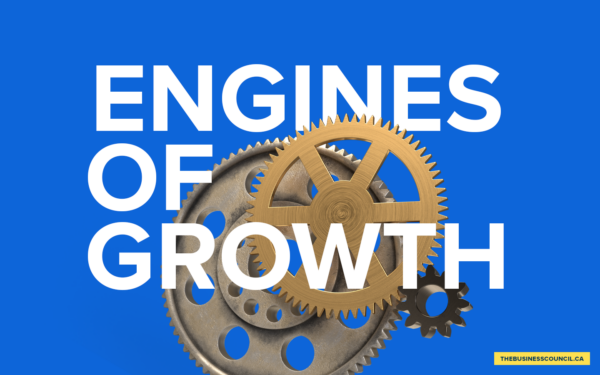Annual Report 2017/2018
Global Ambitions
The next generation of Canadian business leaders is taking on the world
Who We Are
The Business Council of Canada brings CEOs together to shape public policy in the interests of a stronger Canada and a better world.
- 150 chief executives and entrepreneurs of Canada’s leading companies
- Employing 1.7 million Canadians
- Representing half the value of the Toronto Stock Exchange
- Contributing the largest share of corporate income tax
- Responsible for most of Canada’s exports, corporate philanthropy, and business R&D

Message from the Chair
One of a leader’s most important tasks is to prepare his or her organization for what lies ahead. That implies a clear focus on long-term goals, a culture that is open to change, and a resolve not to let team members get trapped in their own comfort zones.

At the Business Council of Canada, we have taken those principles to heart by embracing innovation as a core mission. Innovation and efficiency are the cornerstones of competitiveness, driving each of our businesses forward on the global stage every day. We have welcomed new members and perspectives into our fold, held innovation-themed meetings in Canada, the United States and Europe, and launched several long-term initiatives to more directly support the innovation efforts of member companies. Since its inception in the late 1970s, the Council has represented the chief executives and entrepreneurs of 150 of the country’s largest companies, from all regions and sectors. That has allowed us to play a unique role in public policy development over four decades, channeling the views of Canada’s business leaders on issues including defi cit reduction, national unity, tax reform and international trade. In 2015, we introduced a new category of membership for the founders of some of Canada’s most promising startups. Within our ranks we now have 10 of these next generation business leaders, in fast-growing areas such as fintech, artificial intelligence, robotics, and e-commerce. They bring a fresh outlook to our meetings and policy work, as entrepreneurs focused on scaling up, building strong brands and competing globally – always based on a strong foundation of innovation.
Regardless of its size, every successful company today is conscious of the need to stay abreast of the latest changes in technology. To broaden our understanding of digital transformation and its impact on established and emerging industries, the Council hosted CEO summits in 2017 and 2018 in Waterloo, Silicon Valley, Munich and Toronto. These were among the best attended and most highly rated meetings we have ever held, providing Canadian business leaders with an unparalleled opportunity to meet and learn from some of the world’s most influential innovators in IT, machine learning, additive manufacturing, material development, aerospace and other fields.
We have also created new opportunities for Council members to learn from one another. In the spring of 2018, we successfully piloted a “corporate innovator network” to connect top technology and innovation executives across a broad range of industries. The network is intended to help participants share insights on specific challenges, tackle common problems and provide input into the Council’s own research and policy agenda. In the same vein, we continue to promote closer research collaboration between businesses and Canada’s universities, colleges and polytechnic institutions. The Business/Higher Education Roundtable, which the Council launched in 2015, recently published two new guides that outline practical steps companies can take to forge mutually beneficial R&D partnerships with post-secondary institutions. Meanwhile, Roundtable members are moving forward with a plan to ensure that every post-secondary student in Canada has access to some kind of work-integrated learning opportunity. The goal is to prepare graduates for the jobs of the future, while contributing to a stronger, more innovation-driven economy.
Going forward, we will continue to advocate for a lean and agile public policy framework that supports risk-taking, entrepreneurship and business growth. We have been strong supporters of the federal strategy to accelerate innovation and commercialization through industry-led, market-driven super-clusters. And the Council is working closely with Ottawa on a
policy agenda for the data economy that inspires public trust and positions
Canada to succeed in a more digital world. Canadians are fortunate to live in a time of rapid technological progress and expanding opportunity. On behalf of the Business Council of Canada, thank you for your interest in our innovation agenda. We look forward to working with partners and stakeholders in all areas of society to help build a stronger, more innovative Canada.
Linda S. Hasenfratz
Chair

Message from the President and CEO
As I wrap up my ninth year as leader of the Business Council of Canada, I find myself confronting a range of issues I could not have contemplated in my years as a Minister in Jean Chrétien’s government.

In some ways, it’s the strangest of times. We should be celebrating recent economic performance. Employment, incomes and GDP are all up. Equity markets, as of this writing, are performing well. But there are clouds of uncertainty on the horizon. While the Trump effect on the U.S. economy, with its emphasis on lower taxes and less regulation, has for the most part been positive for business sentiment, his anti-trade antics are unsettling to say the least. The President’s use of national security as a justification for tariffs against Canada and the European Union, together with his evident disrespect for our Prime Minister and other leaders of western democracies, has destabilized economic and security arrangements that have been the basis of our view of the world throughout my lifetime.
I give our government high marks for its efforts to manage the Trump disruption. Some suggest that the government has not made a serious effort to renegotiate NAFTA because it prefers the politics of fighting with Trump. That contradicts what we at the Business Council have observed while engaging step-by-step with federal officials throughout this process. Nevertheless, Trump’s “America First” rhetoric and anti-trade actions have dampened the mood in Canada, as evidenced by the fact that investment is flowing to the United States while slowing here at home. For this reason, we have strongly urged the government to look at the economy through the lens of competitiveness, and not to assume that recent positive economic performance will continue.
Trump’s agenda of lower taxes and lighter regulation – together with the “weaponization of uncertainty”, to use the C.D. Howe Institute’s apt but chilling expression – suggests that we Canadians don’t have unlimited time to respond aggressively. We need to strengthen the ability of Canadian firms to compete, develop new markets for Canadian goods and services, and do damage control for companies and workers hurt by recent U.S. trade actions.
While a renewed NAFTA must remain plan A, plan B should include:
- targeted tax reductions, including accelerated capital cost allowances;
- ensuring that pipelines get built so Canada can diversify its energy exports;
- addressing the regulatory burden imposed by recent changes to the environmental assessment process for major energy projects;
- eliminating barriers to inter-provincial trade;
- ratifying the recently negotiated trade agreement with Pacific Rim countries; and
- launching free trade negotiations with China.
That’s a big shopping list – one that would require committed political leadership. But a burning platform for reform is an opportunity not to be missed. If we fail to act, Canadians may sleepwalk to economic disaster. As I prepare to hand over leadership of the Council in the coming months, we will continue to advocate strongly for a renewed focus on policies to support growth and prosperity. There can be no plan for growth that excludes a healthy and expanding private sector. And for governments, there can be little hope of re-election without economic growth.
The Honourable John P. Manley, P.C., O.C.,
President and CEO

Year in Review
The Business Council of Canada enables CEOs and leading entrepreneurs from every region and every major industry to devote time and energy to addressing key issues that affect the country as a whole. Our primary areas of focus include: economic and fiscal policy; trade and investment; North America; energy and the environment; corporate and public governance; innovation and competitiveness; and jobs and skills.
Economic and fiscal policy
An expanding economy creates jobs, raises household incomes and helps fund public services that keep our communities healthy, educated and safe. After a brief period of above-average growth in 2017, the pace of economic growth in Canada slowed in early 2018, due in part to a softer housing market, disappointing merchandise exports and weaker consumer spending. Most economists were forecasting modest GDP growth in the two-per-cent range for 2018 as a whole, but even that could prove overly optimistic amid rising interest rates and fears of an escalating global trade war.
In this environment, it is essential that federal and provincial governments turn their full attention to addressing the challenges that impede business growth and undermine Canada’s ability to compete for new private investment.
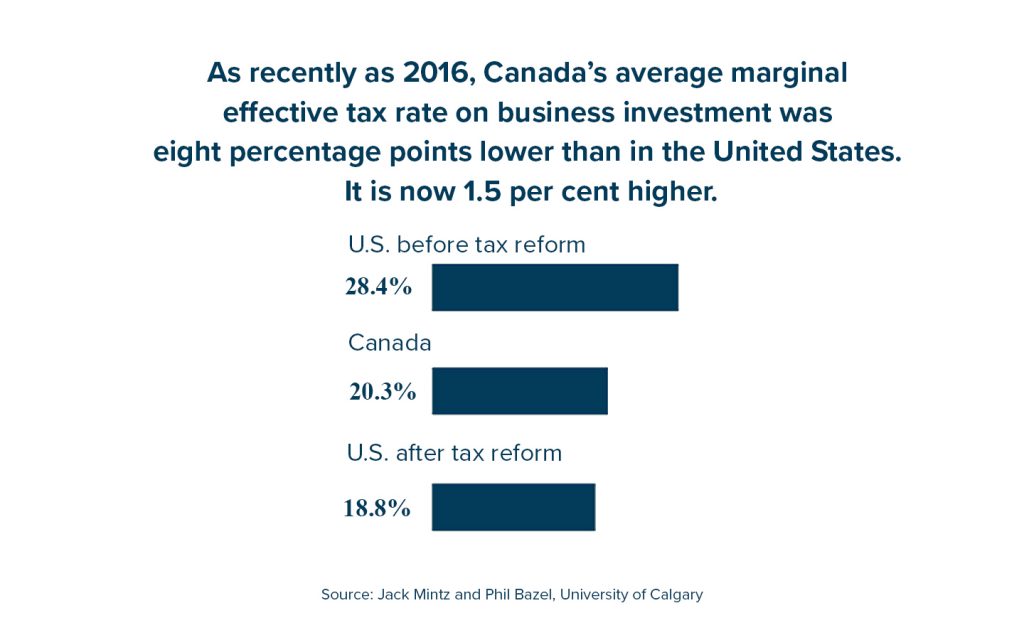
In a recent survey, three-quarters of Business Council members said they were “concerned” or “very concerned” about the competitiveness of Canada’s business environment. A similar proportion—78 per cent—said that, in their opinion, the investment climate had worsened over the past five years. Only one in 10 said it had improved.
One way to reverse this loss of confidence in Canada as a destination for investment is to reform the tax system. For more than a decade, Canada had the benefit of lower statutory corporate tax rates than the United States. But that advantage disappeared this year after Congress approved a sweeping overhaul of the U.S. tax system, cutting the corporate rate to 21 per cent from 35 per cent and allowing companies to immediately write off the full value of investments in new plant and equipment. Nearly two-thirds of Business Council members say those changes will “definitely” (30 per cent) or “probably” (33 per cent) influence their company’s future investment plans.
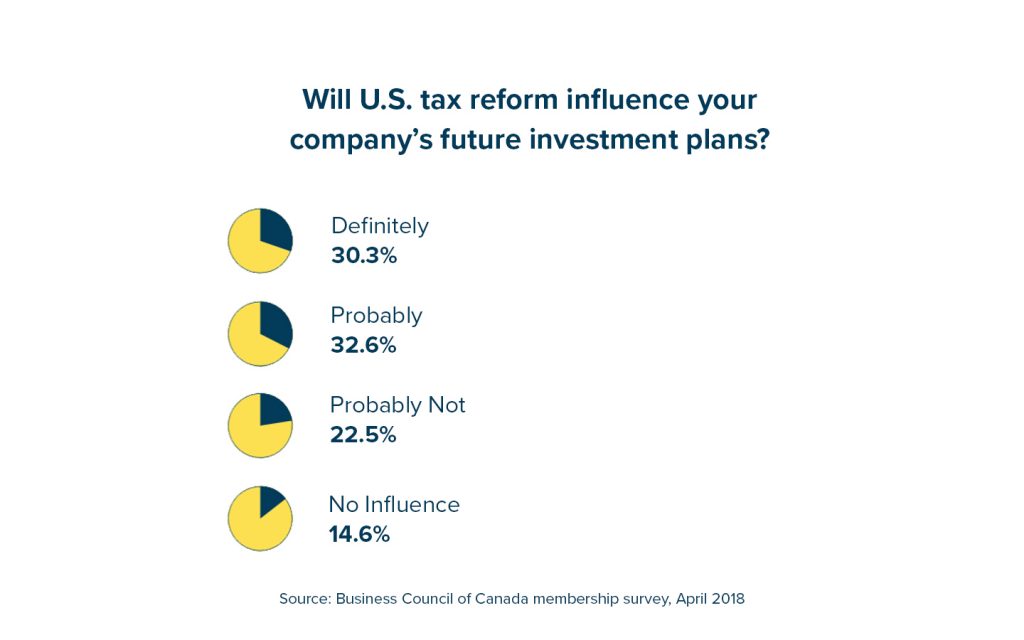
The Business Council has been disappointed by the federal government’s slow response to Canada’s competitiveness challenges. We will continue to press governments at all levels to reduce the high cost of doing business in Canada and create the conditions for stronger growth. At the same time, we remain concerned by the willingness of the federal government and several provinces to run repeated deficits. When the next recession hits and the economy contracts, government revenues will sink and the need for public spending will increase. Now is the time for governments to pay down debt, so they are in a position to respond when the need is greatest.
Trade and investment
World merchandise trade volumes rebounded strongly in 2017, growing by 4.7 per cent. Unfortunately, uncertainty clouds the outlook for 2018 due to heightened trade tensions and a proliferation of protectionist measures around the world. Trade-dependent countries such as Canada are particularly exposed to restrictive trade policies and rising protectionism.
– The CPTPP is projected to boost Canadian GDP by $4.2 billion
– The agreement covers 495 million people
– The CPTPP covers 13.5% of the global economy
In this challenging environment, the Business Council has encouraged the federal government to pursue an ambitious agenda of trade liberalization. In January 2018 we congratulated Prime Minister Justin Trudeau and International Trade Minister François-Philippe Champagne for strengthening Canada’s trade ties with the world’s fastest-growing region. When ratified, the new Comprehensive and Progressive Agreement for Trans-Pacific Partnership (CPTPP) will give Canadian exporters enhanced market access for everything from agricultural goods to advanced manufacturing exports, financial services and forestry products. The success of the CPTPP negotiations sends a powerful signal about the benefits of international cooperation, and underscores Canada’s reputation as a champion of open markets.
“Collectively, Asia Pacific economies are expected to grow 6.1% in each of the next two years— nearly twice the global average.”
“By 2030, the Asia Pacific region will be home to two-thirds of the global middle class.”

Additional trade priorities for the Council include launching negotiations with China, the Association of Southeast Asian Nations (ASEAN) and the four founding members of Mercosur—Argentina, Brazil, Paraguay, and Uruguay.
North America

The ongoing NAFTA talks with the United States and Mexico have been a major source of uncertainty for Canadian companies over the past 12 months. While negotiators have made headway in modernizing certain narrow elements of the 24-year-old agreement, there has been no progress in dealing with any of the more contentious U.S. demands— such as abolishing the Chapter 19 dispute settlement provisions and introducing a new sunset clause that would open the agreement to review every five years. The Business Council has been actively engaged in the negotiations in support of an updated and strengthened NAFTA that protects existing supply chains while enhancing North American competitiveness.
An updated North American trade agreement should include:
- New provisions on intellectual property, e-commerce, the treatment of state-owned enterprises, competition rules, sanitary and phytosanitary measures, telecommunications, customs procedures, labour, environment, procurement, temporary entry and regulatory cooperation
- Measures to promote and support emerging industries and the digital economy
- Enhanced dispute-settlement provisions to ensure that the agreement is enforceable
“In the absence of a swift resolution to this issue, foreign and domestic investors will be left to question whether Canada is a suitable place to invest, create jobs and grow their businesses.”
Business Council of Canada
statement on the Trans Mountain Pipeline, April 11, 2018
In September 2017, shortly after the renegotiations began, the Business Council launched an online, interactive map that identified 7,705 Canadian-owned businesses across the United States and shows how much each U.S. and Congressional district sells to Canada (see here). In May 2018 we updated the map to include the number of jobs supported by Canadian-owned firms at the national, state and congressional-level. This additional information provides a more complete picture of Canada’s significance to the U.S. economy. The map has become a popular resource, widely cited by industry and government officials in both countries.
Energy and the environment
During the 2015 election campaign, the Liberals promised to transform the process by which Ottawa reviews major energy and resource projects. In early 2018, the government unveiled Bill C-69, which would overhaul the Canadian Environmental Assessment Act and create a new Canadian Energy Regulator to deal with large energy infrastructure and export projects. There are some positive features to the bill, such as earlier engagement with Indigenous communities and a commitment to mandated timelines for decision-making. But the bill also would increase the consultation burden and require project proponents to satisfy additional socioeconomic criteria. It is far from clear that the outcome will meet the test we articulated in several submissions on the subject: more efficient decision-making on key economic projects, and broader public support for those decisions.
The problems with Canada’s environmental assessment process were thrown into sharp relief this year by the efforts of British Columbia’s new NDP government to block the Trans Mountain Pipeline expansion. The project had already received federal and provincial approval and would be subject to some of the most stringent environmental and safety standards anywhere in the world. In May 2018 the federal government announced that it intended to buy the pipeline to ensure its construction, with the aim of returning it to the private sector at some future date. The Business Council voiced support for Ottawa’s intervention to break the political logjam, but believes that ongoing uncertainties surrounding new energy infrastructure have undermined Canada’s reputation as a reliable place in which to do business.
The Business Council of Canada has long supported carbon pricing as a tool to reduce greenhouse gas (GHG) emissions and contribute responsibly to the international effort to address climate change. The federal government has called on all provinces and territories to adopt a carbon-pricing system by January 1, 2019, failing which it will impose its own system. Saskatchewan, however, has launched a constitutional challenge against Ottawa’s plan. Ontario Premier Doug Ford is equally opposed, having run on a promise to dismantle that province’s existing cap-and-trade system. Several other provinces have implemented carbon-pricing schemes but most have done so in a way that adds to the cost of doing business, rather than using the revenues to reduce other taxes. In the absence of any coordinated national response to GHG abatement, Canadian companies will continue to contend with a patchwork of different policies, programs and levies that will make it harder rather than easier to achieve Canada’s international climate commitments.
Corporate and public governance
Modern corporations need to pay serious attention to how they recruit, retain and promote women at all levels, including in the C-suite and corporate boardroom. As Canadian companies have increasingly demonstrated, more diverse management teams bring innovative thinking to marketplace challenges and can inspire more inclusive corporate cultures.
To help companies develop a more thoughtful and coherent approach to diversity, this year the Business Council joined with other leading organizations to establish the Canadian Gender and Good Governance Alliance. Its first task was to develop a “Directors’ Playbook” – a practical guide that companies of all sizes can use to accelerate progress in implementing gender diversity and meeting employee, shareholder and customer expectations.
In its 2018 budget, the federal government proposed changes to the Criminal Code that would expand Canada’s enforcement options in responding to serious corporate crime. The legislation, which received Royal Assent in June 2018, creates an incentive for companies to self-report cases of wrongdoing by their employees. Firms that do so, and cooperate with investigators to bring the individual perpetrators to justice, will have an opportunity to demonstrate their commitment to ethical business practices and avoid potential harm to employees, pensioners and shareholders.
The Business Council of Canada has long advocated for this reform and applauds the government’s decision to bring Canadian practice into line with that of other major OECD countries.
Innovation and competitiveness
Emerging technologies and evolving consumer demands are disrupting established business models, but they’re also creating opportunities for companies to develop better products, become more efficient and find new markets. Business Council members are among Canada’s top R&D investors and play a key role in enabling entrepreneurs and researchers to commercialize their ideas. Their successes strengthen Canada’s economy and help address many of today’s most pressing environmental and social problems.
In spring 2018, the Business Council planted the seeds of a new cross-sector network that will bring together senior technology and innovation executives from a wide range of leading companies. The goal is to help participants tackle common challenges, identify barriers to success and help shape policies that promote business innovation in Canada.
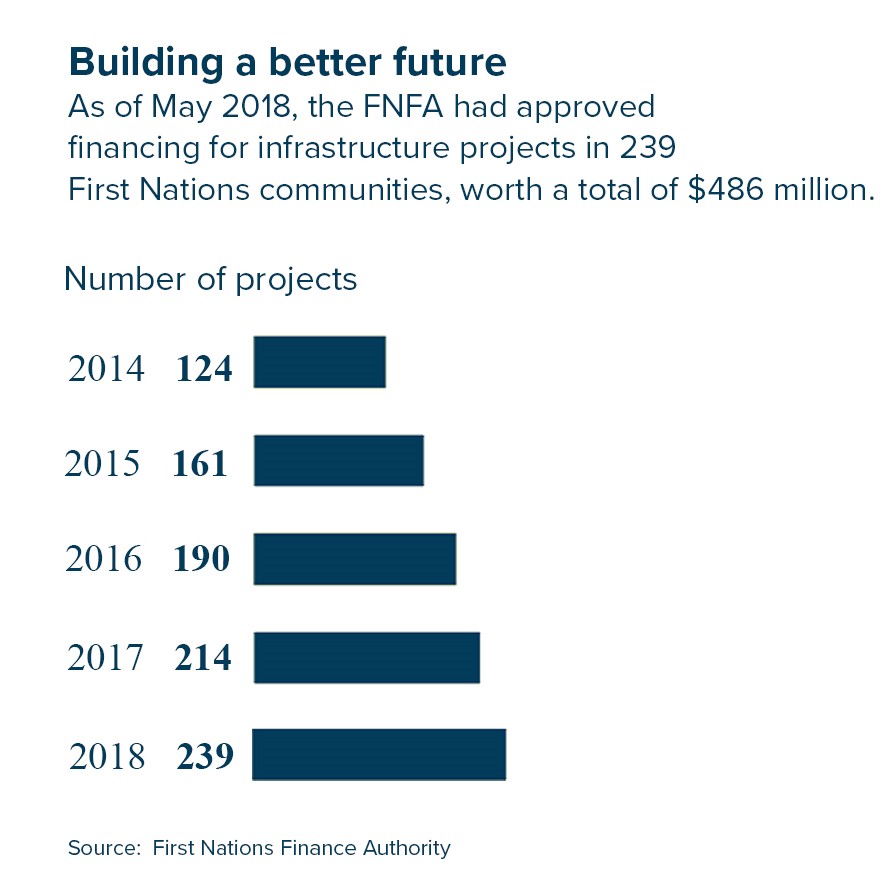
The Council has also been working to strengthen collaboration between industry and post-secondary institutions. In February 2018, the federal government announced its support for five new “superclusters” covering digital technologies, plant-based protein, advanced manufacturing, artificial intelligence and ocean technologies. Together, they will receive up to $950 million in federal funds and billions more from the private sector to develop new partnerships with research and academic institutions. More than half of the Business Council’s member companies are invested in a supercluster, with some participating in two or more initiatives.
The Business Council of Canada was proud to nominate the First Nations Finance Authority (FNFA) for a 2018 Governor General’s Innovation Award. With the support of the National Bank of Canada and its CEO, Louis Vachon, the FNFA has developed an unique funding model that allows Indigenous communities to borrow on favourable terms to undertake badly needed water, housing and other infrastructure projects. The Right Honourable Julie Payette presented the award to Ernie Daniels, FNFA President and CEO, during a ceremony at Rideau Hall on May 23, 2018.
As innovation and digital technologies transform the economy, it’s important that government policies keep pace. In a letter to Treasury Board President Scott Brison in November 2017, the Business Council raised concerns that regulatory barriers are constraining business investment and stymying innovation. The government responded in Budget 2018 by announcing a regulatory modernization initiative, with targeted reviews of regulations in the agri-food, life sciences and transportation industries. The Business Council has been working closely with federal officials on this initiative and in other areas—such as data privacy and cybersecurity— where policies need to reflect the new realities of the digital economy.
Jobs and skills
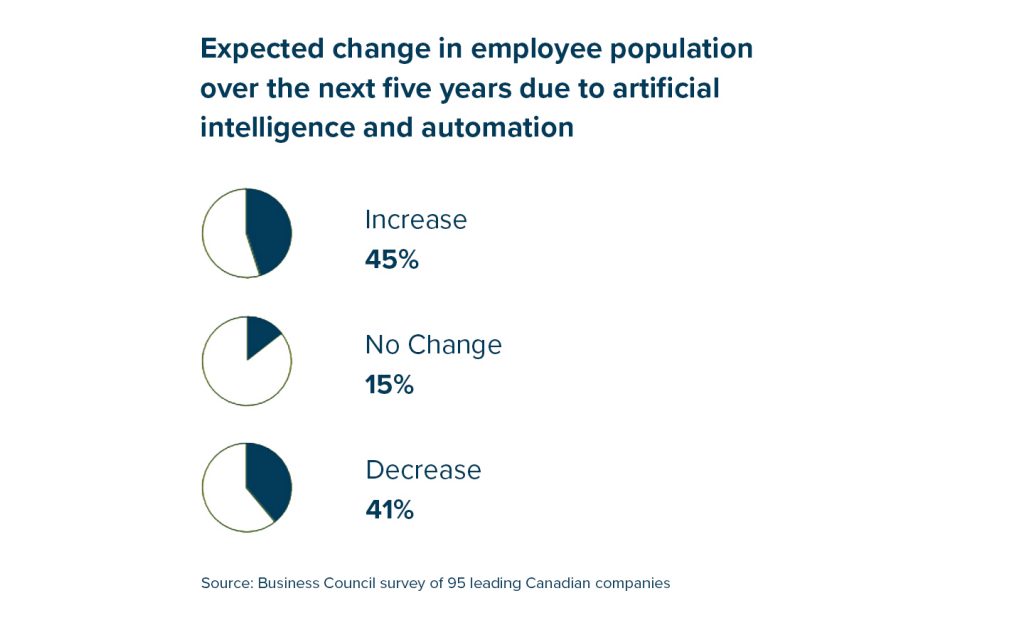
Will new technology trigger widespread job losses? Some analysts believe it is inevitable, but Canada’s business leaders as a group do not share such dark predictions of future unemployment. The Business Council’s 2018 Skills Survey, based on responses from hiring managers at 95 leading Canadian companies, found that 45 per cent expect their workforces to grow as a result of automation and artificial intelligence. Forty-one per cent predict a net decline in employment, while the rest anticipate no significant change.
The survey also revealed the degree to which employers are working harder and spending more to recruit and retain talent in an increasingly competitive labour market. Eighty-three per cent of the companies in the study have a partnership with a post-secondary institution to help them identify potential recruits. Compared to previous years, firms are also spending more on training, with more than half budgeting at least $1,000 annually per employee. And 57 per cent said that a shortage of skilled workers is having either a moderate (40 per cent) or severe (17 per cent) impact on their industry.
“The pace of economic, social and technological change continues to impact the way we work. I look forward to working alongside my business and post-secondary education colleagues to help unleash the skills of Canada’s youth and build a smart, resilient society.”
Dave McKay, President and CEO of RBC and co-chair of the Business/Higher Education Roundtable
Those findings underscore the value of the Business/Higher Education Roundtable (BHER), which brings together the heads of some of Canada’s top companies and post-secondary institutions to assist young Canadians as they transition from school to work, to strengthen Canada’s research capacity, and to help employers adapt to the economy of the future. Created by the Business Council in 2015, BHER has helped launch work-integrated learning programs targeted at financial services, mining and entrepreneurship—with more now in development.
Top 5 fields in which Canadian employers expect to experience skills shortages over the next three years:
1. Information technology
2. Skilled trades
3. Analytics, statistics, quantitative analysis
4. Engineering
5. Leadership management

Breaking Down Barriers
A cross-border CEO task force tackles gender imbalances in business
With NAFTA talks dragging on and trade tensions stirring headlines almost every week, the past year has been a challenging one for Canada–U.S. relations. But on one front, at least, the two countries have made surprising and welcome progress: a bilateral effort to promote opportunities for women in business.
The initiative had its origins in the February 2017 visit of Prime Minister Justin Trudeau to Washington, D.C., for his first face-to-face meeting with President Donald Trump. Among the highlights of the White House visit: a roundtable discussion in the Cabinet Room with women business executives, followed by the launch of a new joint task force, the Canada–United States Council for Advancement of Women Entrepreneurs and Business Leaders.
The Canadians who took part in the roundtable—each of whom agreed to serve on the new Council—included Elyse Allan, President and CEO of GE Canada; Dawn Farrell, President and CEO of TransAlta Corporation; Linda Hasenfratz, CEO of Linamar Corporation and Chair of the Business Council of Canada; Tina Lee, CEO of T&T Supermarket Inc.; Monique Leroux, Chair of Investissement Québec; and Annette Verschuren, Chair and CEO of NRStor Inc.
“We expect this initiative to promote the growth of women-owned enterprises and to further contribute to our overall economic growth and competitiveness, as well as the enhanced integration of our economies,” the Prime Minister and the President said in a joint communiqué. They called on the Council to develop recommendations to address the unique challenges that confront female entrepreneurs and business owners on both sides of the Canada-U.S. border.
Beyond that general mandate, the Council received no specific guidance or direction from either government. In the aftermath of the roundtable, some journalists even questioned whether the initiative was real. “If it was nothing more than a photo-op,” Maclean’s magazine observed, “the ballyhooed White House meeting goes down as another example of female exploitation.”
A survey of 69 Canadian companies representing more than 500,000 employees sheds light on the barriers women face as they seek to move up the ranks. The loss of female talent along the pipeline is not due to lack of ambition or higher attrition: women aspire to promotions at a similar rate and actually leave at a lower rate than their male counterparts.
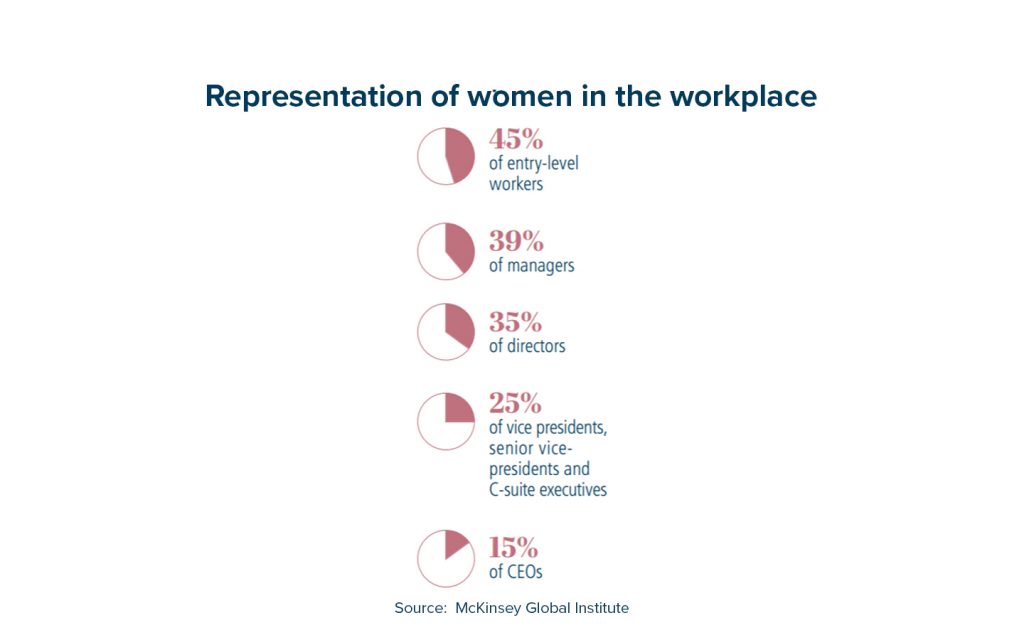
The Council’s members, however, were not about to waste the opportunity to help level the playing field for women in business. Without fanfare, they scheduled calls, shared ideas and ultimately agreed to focus their work on five key goals, or “pillars”: strengthening women-owned businesses; increasing the number of women in science, technology, engineering and math (STEM); supporting women entrepreneurs; increasing women’s access to capital; and advancing women as leaders in the private sector. Then they chose two women to lead each pillar based on their respective strengths and industries.
“The most challenging thing was trying to get us all together in a conference call,” Verschuren recalls of the early days of the Council’s planning process. “But I was so impressed at the engagement of all of the women, who are passionate about and committed to advancing women in business.”
Verschuren worked with Elyse Allan on the first pillar, drafting a report and a series of recommendations to support and grow women-owned businesses. The Council released the report in January 2018, attracting news coverage and social media attention on both sides of the border. “Since we were the first, our pillar process became the template for the others,” Verschuren says. “I took a practical approach and tried to look at things deeply but execute simply. I was a bulldozer to move things forward and get things done. We did focus groups and talked to 200 people, women and men, about barriers. This couldn’t have happened without collaboration.” The collaboration extended well beyond the Council’s 10 members and their staff. As work progressed, the Business Council of Canada, Accenture, McKinsey & Company, Ernst & Young, and Loblaw Companies all contributed time, energy and ideas.
“We achieve so much more collectively than individually,” says Hasenfratz, who partnered with Mary Barra, Chairman and CEO of General Motors Company, to oversee the Council’s work on the second pillar: increasing the number of women in STEM. “It was great to get viewpoints from both countries, from different sectors and industries and from women and men. That was useful to develop more robust solutions and recommendations.” Hasenfratz holds an Honours degree in chemistry, started her career in the pharmaceutical industry and later worked as a machine operator in her father’s auto parts plant, so she was able to draw on her own experiences as a young woman in STEM, in addition to her business background and industry connections.
“Further increasing women in STEM studies and careers is critical to fully harness the potential of 100% of our population.”
Linda Hasenfratz, CEO of Linamar Corporation
Barra, for her part, began working in the automobile industry at age 18, checking fender panels and inspecting hoods to pay her tuition while studying for a bachelor’s degree in electrical engineering. She noted that the share of girls interested in studying computer science plummets from middle school to high school. “These girls need a path, they need support, they need more role models,” Barra said.
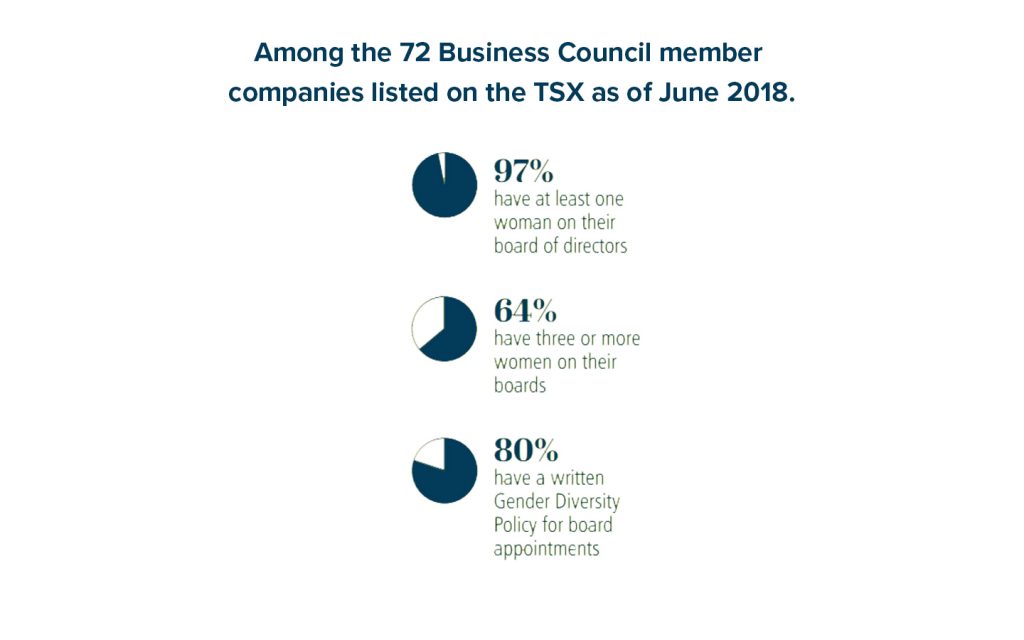
While the Council is composed of women, its members are quick to acknowledge the role that men must play in addressing gender imbalances in business. “Eighty per cent of the power in our country is held by men, so they need to participate in this issue and they need to lead the change,” Verschuren says. “I’ve been in business for 41 years, and I love working with men, but they’ve got to pick it up.”
As for the next steps? “That’s where the hard work of execution begins,” Verschuren acknowledges. Adds Hasenfratz: “We’re still thinking through where to go after this. We’d love to see the recommendations implemented and track progress and statistics around positive momentum.”
An education in STEM is one of the most valuable tools for launching a new business. While more women are studying and having successful careers in STEM fields, they’re still not yet at parity with their male counterparts in many areas. Key barriers include:
– Conscious and unconscious biases
– Lack of awareness of stem programs and opportunities
– Limited access to role models and mentors

Global Ambitions
The next generation of Canadian business leaders is taking on the world
In 2011, the Business Council of Canada created a new category of membership to recognize some of the country’s most successful young entrepreneurs. These “next-generation business leaders” represent firms that are smaller than other Business Council member companies, but fast-growing and innovative. Their experiences underscore an important fact of modern business life. In the past, companies oft en waited until they reached a certain size before pursuing international sales. In contrast, today’s startups tend to think and act globally right out of the gate. On the following pages, short profiles of nine next-generation business leaders.
“The opportunity to network with 150 chief executives who represent a huge part of the economy is pretty invaluable.”
Dax Dasilva, CEO of Lightspeed POS
Kelsey Ramsden
President | Belvedere Place Contracting Ltd

Kelsey Ramsden lives in London, Ontario, but spends much of her time running Belvedere Place, a land developer and construction group based in Kelowna, B.C. Belvedere’s construction arm specializes in civil engineering projects, such as roads, bridges and dams, in Western Canada and the Caribbean.
She also draws on her experiences to coach other up-and-coming business owners around the world. In this “wingman” role, as she calls it, Ramsden provides advice to help entrepreneurs scale up their companies.
Canadians, she says, are well-suited to the role of business mentor and coach. “We’re known to be quite likeable, but also relatively conservative. We’re not as far to one edge as America is, and not as far to the other edge as some older, more traditional economies in places like Europe. People tend to like the perspective that Canadian advisors can bring.”
Not that Ramsden herself fits neatly into any stereotype. On the contrary, she takes pride in choosing the path less travelled. “While so many raced for the safe centre, I stuck to the edges,” she wrote recently about her approach to business. “Try something, do something, cling to the edge, get uncomfortable. Robots will take care of the things that can be taught. Renegades, the rest.”
John Baker
President & CEO | D2L Corporation

Thinking globally comes naturally when more than 80 per cent of your sales are outside Canada. Still, John Baker gives full marks to Canada’s education system for helping to set the stage for the success of D2L, the Waterloo, Ontario-based education software company he founded in 1999.
“Canada has a great education track record,” he says. “Growing up in this environment—and having a clear understanding of what great education can look like—has helped us build technology that really allows our clients to excel.” Baker started D2L, originally known as Desire2Learn, in 1999 while studying engineering at the University of Waterloo. The company now has 700 employees, with offices in the United States, Australia, Brazil, Singapore and Europe. Its cloud-based learning platform, Brightspace, is used by more than 1,200 schools, colleges, universities and businesses around the world.
One such client is the California State University campus in Long Beach, California. Before the campus began using Brightspace, fewer than half its students managed to earn a degree. Today, it boasts the highest graduation rate among Cal State’s 23 campuses. That’s proof, Baker says, of the superiority of D2L’s “competency-based” learning model, which allows students to work at their own pace but requires that they demonstrate proficiency at each level before moving on to the next.
“We’ve been doing a very good job of helping companies start.”
John Baker, D2L
Baker would like to see Canada become equally successful at nurturing more fast-growing, global enterprises. As a country, he says, “we’ve been doing a very good job of helping companies start—whether it’s with innovation hubs, accelerators or other activities that spark entrepreneurship. But we need to do a better job of helping companies go from revenues of $100 million to over a billion.
Jean-François Gagné
Founder & CEO | Element AI

It’s no secret that Canadians are in the vanguard of recent advances in artificial intelligence. Within that highly specialized field, few companies are making a bigger splash than Montreal’s Element AI.
Since its launch in late 2016, Element AI has focused on turning artificial intelligence research into ground-breaking business solutions for financial services, manufacturing, supply-chain management and retailing. Jean-François Gagné, the company’s co-founder and CEO, cites the example of insurance claims. “We totally transform the claims process as a whole, so that it’s run by artificial intelligence instead of by people.”
Element AI already has 300 employees in Canada, Singapore, South Korea and the United Kingdom. It has also attracted an international suite of top-drawer investors, including Microsoft Ventures, Fidelity Investments, China’s Tencent Holdings, and South Korea’s Hanwha Investment & Securities.
Gagné gives much of the credit for Canada’s leading role in AI to sustained public investment in research, and to a handful of visionary individuals associated with the Canadian Institute for Advanced Research. “When it comes to the quality and relevancy of [AI] talent, Canada is one of the best countries,” he says.
Ethan Song
Co-Founder & CEO | Frank and Oak

Founded in 2012 by childhood friends Ethan Song and Hicham Ratnani, Frank And Oak is the very model of a 21st century retailer. For starters, the Montreal-based clothing company has carved out a distinctive identity as a brand for millennials. It generates most of its sales online, and embraces sustainability, diversity and inclusion as cornerstones of its business.
Frank And Oak donates five dollars from every purchase of its “And” garment collection to Montréal Pride which, among other activities, organizes the city’s annual Pride parade. The collection was created in collaboration with Petites-Mains, a non-profit group that helps disadvantaged women learn a trade. The company is aiming to adopt sustainable production methods for most of its garments by the end of 2018. That includes using recycled polyester and organic fibres, and eco-friendly denim.
Frank And Oak’s 260 employees come from 20 different countries. Song himself came to Canada from China when he was six.
Even while pursuing an international clientele, Song says, he and his colleagues have “specifically positioned Frank And Oak as a Canadian brand. We think that Canada’s efforts on the environment are starting to be recognized. We want to be recognized as innovators both in sustainability and in terms of the future of retail.”
Michael McDerment
Co-Founder & CEO | Freshbooks

Mike McDerment is living proof of the unpredictable twists and turns that mark the careers of many successful entrepreneurs. McDerment studied commerce at Queens University, but left during fourth year to start a marketing and design business. One day in 2003, while updating financial records on his computer, he mistakenly erased an invoice that he had meant to save.
That slip planted the seed for FreshBooks, whose user-friendly book-keeping software has attracted more than 10 million users in 120 countries. More than 80 percent of FreshBooks’ business now originates outside Canada.
As McDerment sees it, Canada is a good place from which to build a globally
focused business. He credits Canada’s public healthcare and education systems, as well as incentives such as the federal Scientific Research and Experimental Development tax credit. Venture capital has also become more readily available.
“I know we’ve played a role in helping people believe they can build businesses here.”
Michael McDerment, Freshbooks
Most important however, is a change in mindset. “It used to be that success [meant] moving to Silicon Valley,” McDerment notes. “You started a company here and you moved. But now, people believe success is building here, and that’s great.”
“More companies are successfully scaling up, so business owners can look at examples ahead of them. I know we’ve played a role in helping people believe they can build businesses here.”
Charles Deguire
Co-Founder, President & CEO | Kinova

Charles Deguire gained a passion for robotics in his early 20s as he watched his three great-uncles, all stricken with muscular dystrophy, navigate their wheelchairs through the family’s summer vacation home on the Gaspé peninsula.
“They were losing their physical capacity each year,” Deguire recalls, “but they were improving their lives with new tools to open doors and pick up things on the floor. For me, the young engineer, it was an amazing moment to realize that this is what technology was meant to do.” And so KINOVA was born.
The company has won worldwide acclaim for its pioneering robotic devices for people with disabilities. As well, it now offers robotics platforms for operating-room surgeons and a wide variety of research applications. KINOVA sells its products in more than 40 countries; customers include NASA, Toyota and Google.
“From day one we knew that most of our business was not coming from Canada,” Deguire says. “We were born global.” Deguire also chairs a federal panel on advanced manufacturing, one of six announced in the 2017 federal budget to create jobs and sharpen Canada’s international competitiveness. He says government can accelerate the growth of the tech sector through lighter regulation and by being an early adopter. “The biggest buyers in Canada are governments. If they want to create innovation, they need to adopt innovation. It’s as simple as that.”
Dax Dasilva
Founder & CEO | Lightspeed POS Inc.

In stores and restaurants, it’s not unusual to see staff taking orders on an iPad. Most of the time they’re using cloud technology developed by Lightspeed POS, the Montreal-based company that Dax Dasilva started in 2005. Lightspeed’s industry-leading tools allow independent retailers to run brick-and-mortar and online stores from one platform – managing inventory, placing orders with suppliers, tracking sales and using customer purchase history to devise better sales strategies.
Dasilva traces his interest in software to the day his father, a graphic designer and communications director, brought home an Apple Macintosh. As a teenager, he apprenticed with a Mac developer and started building apps for companies in British Columbia, his home province.
Lightspeed now has more than 50,000 customers around the world, who collectively process more than $15 billion (U.S.) a year in transactions. The company employs more than 600 people in North America, Europe and Australia. “The mission of Lightspeed,” Dasilva says, “is to empower independent businesses and provide them with the tools to flourish.”
Nicole Verkindt
Founder & CEO | Off set Market Exchange (OMX)

Combat boots, radar equipment, corrugated boxes and fuel tanks are just a handful of the many thousands of items available at any one time on OMX’s global business-to-business (B2B) procurement platform.
“We’re positioning ourselves as the Expedia of procurement because we’re the only platform in the world that reaches in and grabs all the opportunities from all industrial B2B procurement platforms,” says Verkindt, who won Startup Canada’s female entrepreneurship award in 2017. TV viewers also know Verkindt from her season as one of the hard-nosed investors on CBC’s Dragons’ Den.
Toronto-based OMX, or Offset Market Exchange, gives government and corporate buyers access to more than 60,000 suppliers around the world. Its platform vastly expands procurement options by classifying prospective suppliers by region, size, local content, certifications and capability.
The idea for OMX came to Verkindt while she was working in her family’s high-tech defence equipment business, which dealt mainly with governments and with companies bidding for large government contracts. She realized that pressure was growing on bidders to demonstrate their programs’ economic benefits through so-called “offsets”— for example, by promising to purchase a specified amount from local suppliers, or by investing in local industries. OMX’s sophisticated technology helps clients identify qualified suppliers and assess the impact of more diverse sourcing.
Michael Katchen
Founder & CEO | Wealthsimple Inc.

“Meet the 28 year-old terrorizing Bay Street” blared the headline on a feature story about Mike Katchen in the October 2016 edition of a popular business magazine.
“Terrorizing” might seem an odd word to use in describing the highly approachable Katchen. But his company, Wealthsimple, is a leader in the growing field of “robo-advisors” that are disrupting the mutual fund and retirement-savings business. These technology start-ups enable individuals to “invest on autopilot,” as Wealthsimple puts it, with simplified sign-up procedures, no account minimums, and fees that are a fraction of those charged by traditional financial advisors. Using sophisticated algorithms, Wealthsimple invests in globally diversified portfolios of low-cost exchange-traded index funds modeled on research used by institutional fund managers.
Katchen was 26 when he founded Wealthsimple in 2014. By the time he turned 30, the Toronto-based company had 160 employees and was managing more than $2 billion in assets in Canada, the United States and the United Kingdom.
Educated at the Ivey Business School in London, Ontario, Katchen began his career in Silicon Valley, but moved back to Canada because “there’s a recognition that Canada has some of the top talent in the world, in particular in technical roles. At a time when a lot of places seem to be closing themselves off, Canada has this idea of openness and a global viewpoint.”

Paying Their Share
Now in its fifth year, the PwC Total Tax Contribution survey measures the impact of large companies on public finances in Canada. This year, PwC analyzed data from 87 of the Council’s member companies— a cross-section of leading firms in financial services, energy and resources, manufacturing, construction, transportation, telecommunications, retailing, agrifood, information technology, business services and other sectors. The survey is designed to capture the full range of taxes, fees and other payments to government by large businesses in Canada. It includes the many different kinds of taxes borne by companies (taxes that are a direct cost to the business) as well as the taxes they collect from employees and customers on
behalf of government. The full report can be found on our website:
thebusinesscouncil.ca.

The 87 companies that participated in the study were responsible
for nearly one-fifth of all corporate income
tax paid to Ottawa in 2016. In total
they contributed $64.6 billion in
taxes to all levels of government,
and paid an additional $3.7 billion
in royalties and other fees.

When the economy grows and businesses do well, corporate income tax payments increase exponentially. In 2016, Canada’s economy expanded by 2.5%. Meanwhile, the companies that participated in the survey paid almost one-third more in CIT compared to the previous year.

Business Council members are a vital source of well-paid jobs in Canada. The 87 companies that took part in the survey employed more than one million people in 2016 and paid them an average of $66,788, generating $24,442 per person in employment taxes. The wages they paid were 32 per cent higher than the national average for full-time workers in Canada.
Total Tax Rate
Over the past five years, the overall tax burden on survey participants has increased. The Total Tax Rate is calculated by dividing a company’s tax payments (corporate income tax and all other taxes borne) by its earnings before taxes.
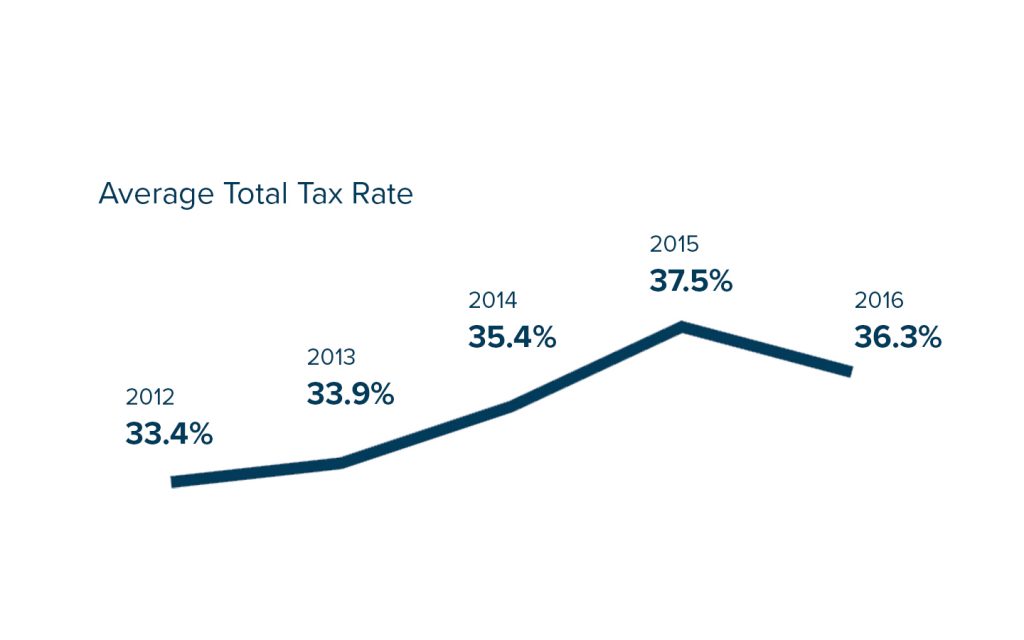
Compliance Burden
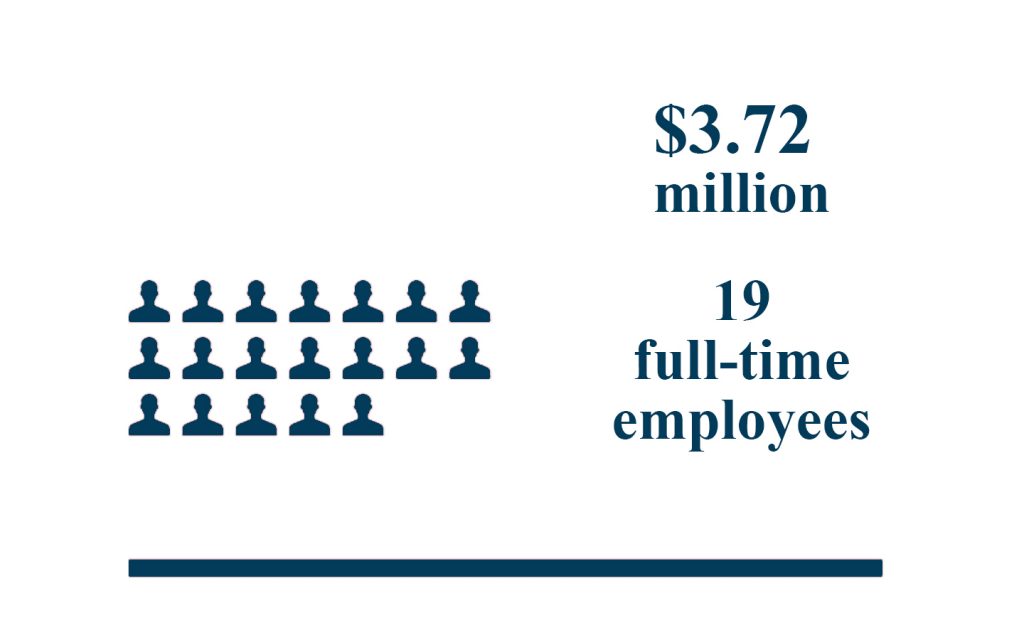
The cost of tax compliance continues to climb. On average, the 87 companies that took part in the survey spent $3.72 million and employed 19 full-time employees to keep up with their Canadian tax obligations.
Who Benefits?

For every $100 of value generated
by the companies in the survey, $36
went to Canadian governments and $37.30 was paid to employees. The smallest share— $26.70—was retained
as after-tax profit and either reinvested in the business or paid out to shareholders.
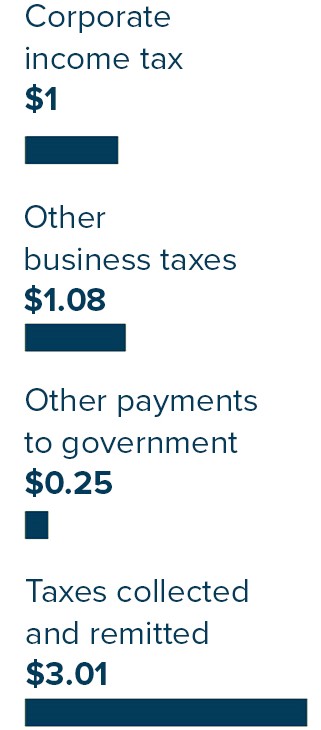
The Total Tax Contribution study tracks 68 different taxes, fees and royalties that large companies pay to the three levels of government.
For every dollar they paid in corporate income tax in 2016, they contributed another $1.08 in other business taxes, 25 cents in government fees
and other charges, and $3.01 in taxes collected and remitted on behalf of their employees and customers.

CEO Summits
Three times a year, the full membership of the Business Council of Canada meets to discuss critical domestic and international issues, the economic outlook, current business challenges and emerging opportunities. These events provide Canada’s business leaders with unique opportunities to exchange views with their peers as well as senior policy makers, top thinkers and innovators from around the world. In 2017-18, Business Council members met in Silicon Valley, Munich and Toronto.
Silicon Valley
Palo Alto, California, epicentre of the digital revolution and home to one of the world’s most dynamic innovation ecosystems, was a fitting setting for the Council’s autumn 2017 meeting. The two-day gathering included interactive sessions with some of the tech sector’s leading figures, including Google’s Eric Schmidt, Microsoft’s Satya Nadella, Cisco’s Chuck Robbins and Dell’s Michael Dell.
Council members visited Google, Facebook and LinkedIn, as well as the birthplace of Hewlett-Packard and the headquarters of one of the world’s most closely watched additive-manufacturing startups, Carbon. Tesla co-founder J.B. Straubel spoke about the future of solar-powered transportation, and a panel of investors and CEOs described how the CIA identifies and funds cutting-edge technologies that hold promise for the U.S. national security and intelligence community. The meeting wrapped up with a visit to Sand Hill Road, known for its concentration of venture capital firms, and a dialogue with Marc Tessier-Lavigne, Canadian-born President of Stanford University.
Munich
Tourists flock to the Bavarian capital for its museums and lively beer halls, but Munich is equally renowned as an innovation hub and centre of advanced manufacturing. The Council’s New Year members’ meeting opened with a site visit to KUKA, one of the world’s leading suppliers of industrial robots and factory automation technology. After that, members toured the R&D campus of Airbus Defence and Space and heard from CEO Dirk Hoke about the company’s digital transformation strategy. Then it was on to the headquarters of BMW for private tours of the BMW museum and briefings on how disruptive technologies and changes in consumer behaviour are reshaping the global automotive business.
The next day, Council members gathered in the new global headquarters of Siemens, where they were joined by International Trade Minister François-Philippe Champagne and top business leaders from Germany, France and the United Kingdom. The program focused on European models of innovation, the future of the Western alliance, the implementation of the Canada-European free trade agreement and the outlook for transatlantic trade. The meeting concluded with a reception and dinner at the historic Hotel Bayerischer Hof, featuring a Canada-Europe CEO roundtable on global business conditions.
Toronto
The Council’s spring 2018 meeting began with a visit to the new headquarters of the non-profit organization WE, founded by Craig and Marc Kielburger. Housed in a repurposed, century-old building in Toronto’s historic Corktown neighbourhood, the WE Global Learning Centre is a state-of-the-art community space dedicated to youth engagement in social initiatives. The Kielburger brothers took the opportunity to thank the many Canadian business leaders whose donations brought the 43,000-square-foot centre to life–including Hartley Richardson of Winnipeg-based James Richardson & Sons, who first approached Craig Kielburger with the idea. Also on the program: a briefing by Richard Edelman, architect of the Edelman Trust Barometer, on business leadership in an age of public distrust; a panel on social innovation; elevator pitches from young social entrepreneurs; and presentations on the role of business in creating careerboosting opportunities for Canadian students and new graduates.
After dinner, veteran White House correspondent Ann Compton of ABC News moderated a discussion on “Navigating Trump’s America”, with Republican political consultant Karl Rove, former adviser to President George W. Bush, and journalist Ezra Klein, co-founder of the new media website Vox.
The following morning, Deloitte Canada hosted a series of presentations and interactive sessions on the economic outlook, Canadian competitiveness, the implications for Canada of U.S. tax reform, and the impact of rising populism on governments and businesses across North America and Europe. Speakers included David Rosenberg, Chief Economist and Strategist at Gluskin Sheff, and Nik Nanos, Chairman of Nanos Research and author of “The Age of Voter Rage”. The meeting wrapped up with a CEO roundtable on current business conditions.











